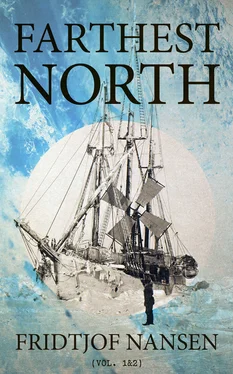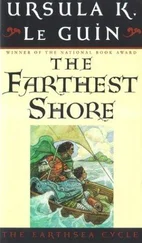“How long may we suppose such a voyage to occupy? As we have already seen, the relics of the Jeannette expedition at most took two years to drift along the same course down to the 80th degree of latitude, where we may, with tolerable certainty, count upon getting loose. This would correspond to a rate of about two miles per day of twenty-four hours.
“We may therefore not unreasonably calculate on reaching this point in the course of two years; and it is also possible that the ship might be set free in a higher latitude than is here contemplated. Five years’ provisions must therefore be regarded as ample.
“But is not the cold in winter in these regions so severe that life will be impossible? There is no probability of this. We can even say with tolerable certainty that at the Pole itself it is not so cold in winter as it is (for example) in the north of Siberia, an inhabited region, or on the northern part of the west coast of Greenland, which is also inhabited. Meteorologists have calculated that the mean temperature at the Pole in January is about -33° Fahr. (-36° C), while, for example, in Yakutsk it is -43° Fahr. (-42° C), and in Verkhoyansk -54° Fahr. (-48° C.). We should remember that the Pole is probably covered with sea, radiation from which is considerably less than from large land surfaces, such as the plains of North Asia. The polar region has, therefore, in all probability a marine climate with comparatively mild winters, but, by way of a set-off, with cold summers.
“The cold in these regions cannot, then, be any direct obstacle. One difficulty, however, which many former expeditions have had to contend against, and which must not be overlooked here, is scurvy. During a sojourn of any long duration in so cold a climate this malady will unquestionably show itself unless one is able to obtain fresh provisions. I think, however, it may be safely assumed that the very various and nutritious foods now available in the form of hermetically closed preparations of different kinds, together with the scientific knowledge we now possess of the food-stuffs necessary for bodily health, will enable us to hold this danger at a distance. Nor do I think that there will be an entire absence of fresh provisions in the waters we shall travel through. Polar bears and seals we may safely calculate on finding far to the north, if not up to the very Pole. It may be mentioned also that the sea must certainly contain quantities of small animals that might serve as food in case of necessity.
“It will be seen that whatever difficulties may be suggested as possible, they are not so great but that they can be surmounted by means of a careful equipment, a fortunate selection of the members of the expedition, and judicious leadership; so that good results may be hoped for. We may reckon on getting out into the sea between Greenland and Spitzbergen as surely as we can reckon on getting into the Jeannette current off the New Siberian Islands.
“But if this Jeannette current does not pass right across the Pole? If, for instance, it passes between the Pole and Franz Josef Land, as above intimated? What will the expedition do in that case to reach the earth’s axis? Yes, this may seem to be the Achilles’ heel of the undertaking; for should the ship be carried past the Pole at more than one degree’s distance it may then appear extremely imprudent and unsafe to abandon it in mid-current and face such a long sledge-journey over uneven sea-ice, which itself is drifting. Even if one reached the Pole it would be very uncertain whether one could find the ship again on returning. ... I am, however, of opinion that this is of small import: it is not to seek for the exact mathematical point that forms the northern extremity of the earth’s axis that we set out, for to reach this point is intrinsically of small moment. Our object is to investigate the great unknown region that surrounds the Pole , and these investigations will be equally important, from a scientific point of view, whether the expedition passes over the polar point itself or at some distance from it.”
In this lecture I had submitted the most important data on which my plan was founded; but in the following years I continued to study the conditions of the northern waters, and received ever fresh proofs that my surmise of a drift right across the Polar Sea was correct. In a lecture delivered before the Geographical Society in Christiania, on September 28, 1892, I alluded to some of these inquiries. 10I laid stress on the fact that on considering the thickness and extent of the drift-ice in the seas on both sides of the Pole, one cannot but be struck by the fact that while the ice on the Asiatic side, north of the Siberian coast, is comparatively thin (the ice in which the Jeannette drifted was, as a rule, not more than from 7 to 10 feet thick), that on the other side, which comes drifting from the north in the sea between Greenland and Spitzbergen, is remarkably massive, and this, notwithstanding that the sea north of Siberia is one of the coldest tracts on the earth. This, I suggested, could be explained only on the assumption that the ice is constantly drifting from the Siberian coast, and that, while passing through the unknown and cold sea there is time for it to attain its enormous thickness, partly by freezing, partly by the constant packing that takes place as the floes screw themselves together.
I further mentioned in the same lecture that the mud found on this drift-ice seemed to point to a Siberian origin. I did not at the time attach great importance to this fact, but on a further examination of the deposits I had collected during my Greenland expedition it appeared that it could scarcely come from anywhere else but Siberia. On investigating its mineralogical composition, Dr. Törnebohm, of Stockholm, came to the conclusion that the greater part of it must be Siberian river mud. He found about twenty different minerals in it. “This quantity of dissimilar constituent mineral parts appears to me,” he says, “to point to the fact that they take their origin from a very extensive tract of land, and one’s thoughts naturally turn to Siberia.” Moreover, more than half of this mud deposit consisted of humus, or boggy soil. More interesting, however, than the actual mud deposit were the diatoms found in it, which were examined by Professor Cleve, of Upsala, who says: “These diatoms are decidedly marine ( i.e. , take their origin from salt-water), with some few fresh-water forms which the wind has carried from land. The diatomous flora in this dust is quite peculiar, and unlike what I have found in many thousands of other specimens, with one exception, with which it shows the most complete conformity—namely, a specimen which was collected by Kellman during the Vega expedition on an ice-floe off Cape Wankarem, near Bering Strait. Species and varieties were perfectly identical in both specimens.” Cleve was able to distinguish sixteen species of diatoms. All these appear also in the dust from Cape Wankarem, and twelve of them have been found at that place alone, and nowhere else in all the world. This was a notable coincidence between two such remote points, and Cleve is certainly right in saying: “It is, indeed, quite remarkable that the diatomous flora on the ice-floes off Bering Strait and on the east coast of Greenland should so completely resemble each other, and should be so utterly unlike all others; it points to an open connection between the seas east of Greenland and north of Asia.” “Through this open connection,” I continued in my address, “drift-ice is, therefore, yearly transported across the unknown Polar Sea. On this same drift-ice, and by the same route, it must be no less possible to transport an expedition.”
When this plan was propounded it certainly met with approval in various quarters, especially here at home. Thus it was vigorously supported by Professor Mohn, who, indeed, by his explanation of the drift of the Jeannette relics, had given the original impulse to it. But as might be expected, it met with opposition in the main, especially from abroad, while most of the polar travellers and Arctic authorities declared, more or less openly, that it was sheer madness. The year before we set out, in November, 1892, I laid it before the Geographical Society in London in a lecture at which the principal Arctic travellers of England were present. After the lecture a discussion took place, 11which plainly showed how greatly I was at variance with the generally accepted opinions as to the conditions in the interior of the Polar Sea, the principles of ice navigation, and the methods that a polar expedition ought to pursue. The eminent Arctic traveller, Admiral Sir Leopold M’Clintock, opened the discussion with the remark: “I think I may say this is the most adventurous programme ever brought under the notice of the Royal Geographical Society.” He allowed that the facts spoke in favor of the correctness of my theories, but was in a high degree doubtful whether my plan could be realized. He was especially of opinion that the danger of being crushed in the ice was too great. A ship could, no doubt, be built that would be strong enough to resist the ice pressure in summer; but should it be exposed to this pressure in the winter months, when the ice resembled a mountain frozen fast to the ship’s side, he thought that the possibility of being forced up on the surface of the ice was very remote. He firmly believed, as did the majority of the others, that there was no probability of ever seeing the Fram again when once she had given herself over to the pitiless polar ice, and concluded by saying, “I wish the doctor full and speedy success. But it will be a great relief to his many friends in England when he returns, and more particularly to those who have had experience of the dangers at all times inseparable from ice navigation, even in regions not quite so far north.”
Читать дальше












